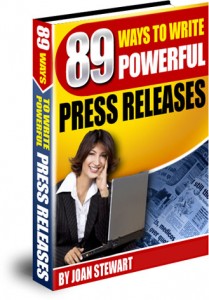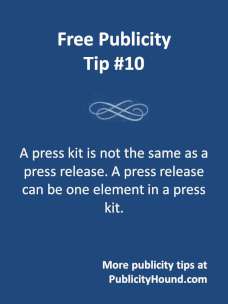This is the latest tip in a series of ”50 Tips for Free Publicity” which I’m pinning on Pinterest. Follow me there, and if you like my tips, comment and repin. Just click the button with the red “Pin It” above.
* * *
Beginning do-it-yourself publicity seekers make this mistake frequently. They confuse a press release with a press kit (same as a media kit).
A press release is simply part of a press kit.
A press kit is a compilation of information for the media, for bloggers, or for anyone who wants more background, details, photos or graphics of you or your company.
Two decades ago, a press kit typically included a folder that held press releases, bios, a one-page summary of a company’s background, fact sheets, frequently asked questions, and photos.
These days, the information is essentially the same, but the material is accessible from your website, usually under one of the navigational buttons. Today’s press kits should also include links to videos if you have them, and links to your social media profiles.
Do’s and Don’ts for Your Press Kit:
- Do update it frequently. It’s amazing how quickly the information can become stale.
- Don’t send press kits unsolicited to media contacts, bloggers or anyone else, particularly if you want them to cover you. If you want to get their attention, you must send a customized pitch. Iit’s essential that you research journalists and bloggers before pitching them, looking for as much information as you can about what they cover as well as personal details you might want to weave into the pitch.
- If you send them a customized pitch and they want more information for the story, you can send them a link to your press kit. Don’t send the kit as an attachment.
- Make high-resolution photos available at at least 300 dots per inch.
Do’s and Don’t s for Your Press Releases
- Use press releases primarily to post online, preferably through a paid press release distribution service like eReleases. Owner Mickie Kennedy is giving away The Big Press Release Samples Book that includes 35 industry-specific press releases and 40 occasion-specific press releases, plus tips for formatting your press release and getting it noticed.
- You can also use press releases as collateral material for the media, bloggers, or anyone who wants more information on whatever you’ve written about.
- If a media contact has asked for a copy of your press release, either send them a link where they can find it online, or put the release in the body of the email. Don’t send it as an attachment.
What other materials do you include in your press kit? Or how have you used your press kit to promote yourself or your business or nonprofit?
* * *


I can add up a few points based on my experience in publishing industry. You can think of adding:
– a price catalogue (a media personmay be a potential customer of the service or the product offering from the organization
– a booklet (this can a sample review booklet or it can discuss some latest research findings based on the industry dealt in)
– a sample article (that needs to complement the news covered in the press release)
– if you are announcing a book release, then sending a tip sheet or a pamphlet will be really beneficial (as it will highlight the main points about the book and ordering info)
– URLs of published reviews, if any. Some publishers send pre-press copies for reiew purpose to bloggers and influencers. (tip: share this information, only if the media person confirms your request)
– Generally, press release writers mention – “For more information contact: emailaddressoftheprrepresentative”. In my opinion, we should mention all the email contacts that may be necessary. This may include email ids of PR rep, publisher, author, sales rep at the relevant points. This will save time for sure. Afterall, why should they hunt for the information when they can be presented on silver platter.
Hope this piece helps.
Priyana, you’ve mentioned some very helpful items to include in a press kit. Love the one about URLs of published reviews, perhaps with a short excerpt from each one. Thanks for rounding out this topic.
I wish to elaborate on the sample article mentioned by me in previous post.
The sample article may be a hot point to establish yourself as an expert. It can either be an informational article that can be used by the reporter in his story or it can be used in the side bars and supporting information.
Moreover, if the press release is used by the reporter online, then in this case, the supporting article will serve as a keyword promotion tool. The article can be structured in a way that it uses keywords intelligently, wherever applicable.
You mentioned sidebars. These are short lists or stories, fact boxes or other information that accompanies the main story. When compiling a press kit, think about what types of information you could add that would complement a main story. Thanks for clarifying.
Many good newsrooms will include images in both high and low res options, for both print and web (bloggers), along w/ whatever photo credits may be required. I totally agree w/ the ‘non attachment’ advice – always better to keep it in the body of the email, plus attachments will sometimes trigger a ‘spam’ warning. Someone already mentioned price/spec sheets, catalogues and brochures; at times, we can add videos, presentations; if it’s a speaker, then links to the YT channel and slideshares. Another part of a good kit (and pressroom) – easy to find/navigate contact info. Don’t want to make a reporter or blogger have to search for it.
Looks like you’re writing a good series here on generating publicity (and Pinterest sharing, I’m learning it) – my quibble is that it’s not ‘free.’ You’re outlining 50 tips – 50!! – that’s a ton of work. Time/work IS money; I’d say it’s not free publicity, it’s hard ‘earned’ media. FWIW.
Davina, I’m not suggesting that you need to use all 50 tips in order to generate “free” publicity. Not all of them apply to everyone. Pick a handful that you think you can do quickly and do them, then identify a few more when you have a little time.
Thanks for the reminder about including photo credits. I had forgotten that!
Joan, thanks for writing a much needed post. I often speak with authors, entrepreneurs, and small business owners who use the terms press release and press kit interchangeably– even though they are quite different. A press kit may contain a press releases, but it should be much, much more as you have described. We’ve been using online press kits for years now and have found that they make a huge difference in the results we get for our clients. Here are three more “must-haves” for a powerful online press kit:
Showcase your media interviews: While videos of yourself are great to put in a press kit if you don’t have media coverage clips yet, videos of your TV appearances are much more powerful. Most TV producers (especially the national shows) want to see that you have previous experience in front of a studio camera and that you can sound bite yourself clearly and concisely. Radio and print are no different. Show an editor at Time your previous mention in Newsweek and you’ll be more likely to be covered there as well.
Provide a printable one-pager: A lot of top newsroom reporters go into their morning pitch meetings with notes on who they want to put on the show. Make their job easier by providing a printable one-pager in your press kit that has your bio, photo, suggested story ideas, and a few possible talking points.
Be part of a database: Placing a link your online press kit on your website is fine; but listing it in a searchable database of experts is even better if you want to be found by top media venues. That’s often where national producers go when they’re in a crunch and need a top quality expert fast– either that or they start contacting their “go-to” publicists for a reliable source.
Fabulous tips, Shannon. You’re so right that videos of an expert appearing on TV are incredibly powerful. Love your tip, too, about offering the link to the online press kit in experts databases. Thanks for adding to the discussion.
Thank you so much for such an amazing article. it helps me to differentiate between press kit and press release. This knowledge enhanced my confidence.